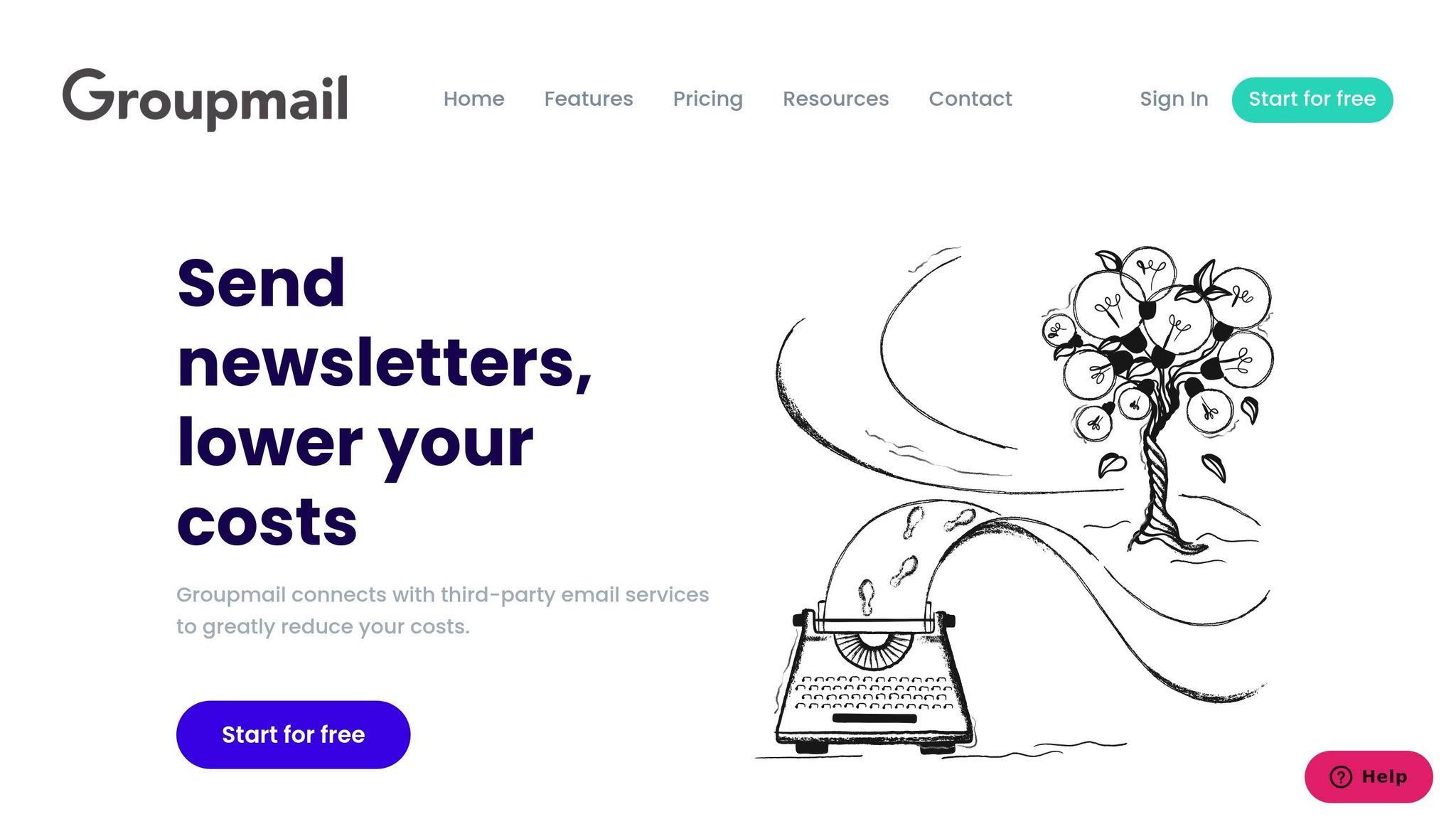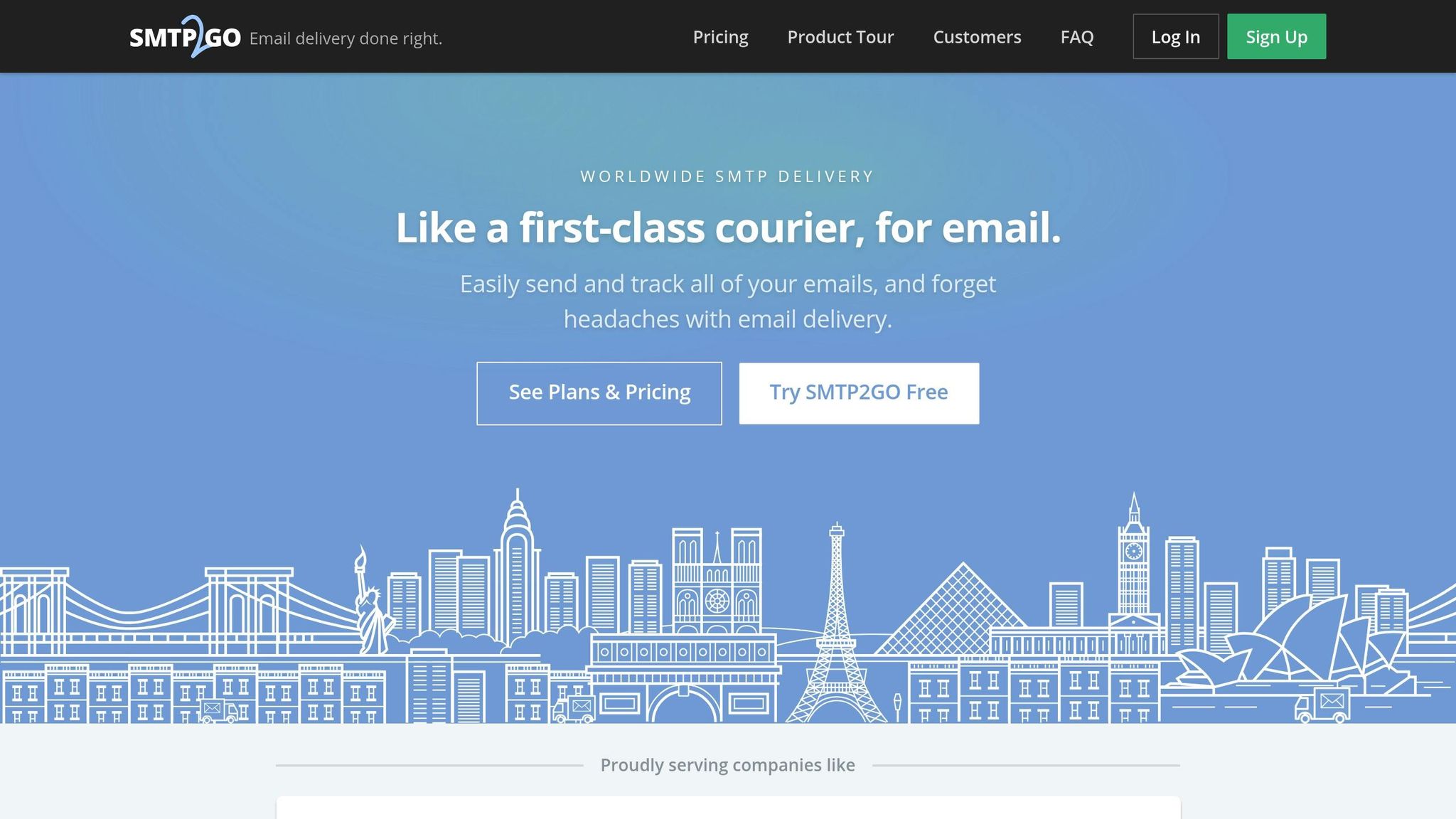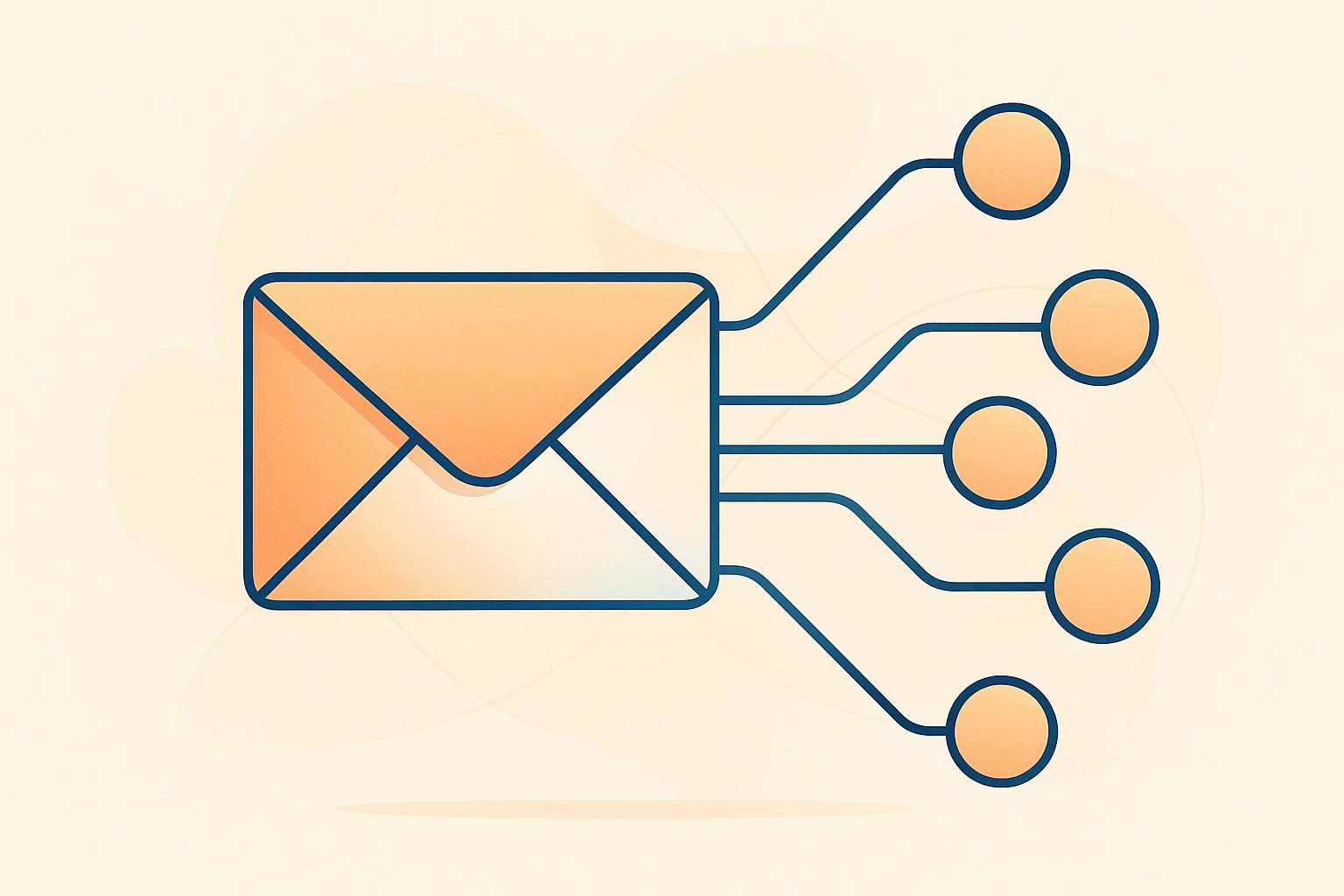Scaling email campaigns can be challenging as your business grows. Traditional email platforms often hit limits with volume, deliverability, and personalization. Third-party email services like SendGrid and SMTP2GO solve these problems by offering tools for high-volume sending, better deliverability, and cost-effective solutions.
Here’s what you need to know:
- Why Use Third-Party Services? They handle technical aspects like IP warming, spam monitoring, and domain reputation, allowing you to focus on creating effective campaigns.
- Key Benefits:
- Improved control over sending domains and IPs.
- Better inbox placement and real-time analytics.
- Scalable pricing based on email volume.
- How to Start: Pair tools like Groupmail with SMTP providers to design, manage, and track campaigns while ensuring reliable delivery.
- Best Practices: Authenticate your domain (SPF, DKIM, DMARC), warm up new IPs gradually, and segment your audience for personalized messaging.
Quick Comparison: SMTP2GO vs. SendGrid
| Feature | SMTP2GO | SendGrid |
|---|---|---|
| Monthly Pricing | $15 (40,000 emails) | $19.95 (50,000 emails) |
| Deliverability | 95.5% | 82.0% |
| Advanced Tools | Basic | A/B testing, validation API |
| User Rating | 4.9/5 | 4.2/5 |
For businesses managing under 500,000 emails per month, SMTP2GO offers simplicity and reliability. For advanced features or larger campaigns, SendGrid is a solid option. Both integrate seamlessly with platforms like Groupmail to streamline your email marketing efforts.
The 7 Best SMTP Service Providers with High Email Deliverability
Key Benefits of Third-Party Email Services
Switching to third-party email services can transform the way you manage your email campaigns. From gaining better control to improving deliverability and reducing costs, these services offer a solid foundation for scaling your email efforts effectively. Let’s break down the key advantages.
More Control Over Your Email Sending
When handling large-scale campaigns, having control over your email processes is essential. Third-party SMTP providers give you the tools to take charge of your campaigns. You can customize sending domains, manage your IP reputation, and fine-tune delivery settings to suit your needs. These providers also offer real-time security features, allowing you to quickly adapt to threats and update protocols without disrupting service. On top of that, you can segment campaigns by reputation tiers and monitor bounce and spam rates closely, ensuring your sender reputation stays intact.
Better Email Deliverability
For campaigns to succeed, your emails need to land in the right inboxes. Third-party email services specialize in maximizing deliverability. They use dedicated monitoring systems and real-time adjustments to keep emails out of spam folders and ensure they’re delivered as intended. With tools to track email performance, monitor bounces, and manage feedback loops, these services help you dodge common issues like blocked or undelivered emails.
Lower Costs for Growing Businesses
Scaling campaigns often means finding ways to manage costs without sacrificing quality. Third-party email services make this possible by charging based on the volume of emails sent. Unlike traditional ISPs, which may restrict email volumes or block direct SMTP connections, these services provide a more flexible and cost-effective solution. For example, combining Groupmail’s user-friendly design tools and analytics with the delivery power of providers like SendGrid or SMTP2GO gives you enterprise-level features without the hefty price tag.
How to Connect Groupmail with Third-Party SMTP Services

Integrating Groupmail with a third-party SMTP service is a straightforward process that combines Groupmail’s design and analytics tools with the delivery power of specialized email providers. Here’s how to set it up.
Connecting Groupmail to a Third-Party Email Provider
You can easily connect Groupmail to a third-party provider like SendGrid or SMTP2Go for greater flexibility and reliable delivery.
To get started, go to Your Profile > Channels. From here, either create a new channel or edit an existing one.
Instead of using traditional SMTP settings, you’ll be connecting via the provider’s API, which is more secure and efficient. Choose your preferred provider and follow the relevant instructions:
During setup, you’ll be asked for details such as your API key, the sending email address, and any necessary authentication. Groupmail makes this process straightforward, but make sure to copy the API key exactly as provided.
After connecting your account, it’s a good idea to test the connection to confirm that everything is configured correctly before sending any campaigns.
Using an API connection ensures faster delivery, improved tracking, and better deliverability—ideal for managing large-scale email campaigns with confidence..
Using Groupmail for Design and Campaign Management
With the connection in place, Groupmail becomes your main tool for managing campaigns, while your email provider handles the email delivery. The platform’s drag-and-drop email builder makes it easy to create professional campaigns. You can use customizable templates, add video or HTML content blocks, and take advantage of the built-in image editor and storage to refine your designs.
Groupmail also offers personalization features to keep your campaigns engaging, even at scale. Its scheduling tool lets you plan campaigns in advance, which is especially helpful for managing multiple large sends. Additionally, the platform automatically handles bounces and unsubscribes, saving you time and effort.
Tracking Performance with Groupmail Analytics
Once your campaigns are live, tracking their performance is crucial. Groupmail provides real-time analytics that give you a clear picture of how your emails are performing. From the dashboard, you can monitor metrics like bounce rates, open rates, and click-through rates, helping you understand the impact of your campaigns.
The analytics system also breaks down performance by audience segments and individual campaigns, making it easier to identify which strategies are most effective. With mobile-optimized reporting, you can keep an eye on your campaign performance wherever you are.
This detailed tracking, combined with the reliability of professional SMTP services, helps you maintain high deliverability rates. For instance, you can quickly address issues like unusual bounce patterns or drops in engagement before they affect your sender reputation.
sbb-itb-2d4bf0e
Best Practices for High-Volume Email Sending
Scaling email campaigns isn’t just about having a strong SMTP connection. To ensure your emails land in inboxes as your volume grows, you need to follow certain practices. Verifying your sender identity is a key step to improving deliverability, and it aligns seamlessly with Groupmail’s built-in design and analytics tools.
Set Up Email Authentication for Your Domain
Email authentication is how you prove to internet service providers (ISPs) that you’re a trustworthy sender.
Start by adding SPF (Sender Policy Framework) records to your domain’s DNS settings. These records tell receiving servers which IP addresses are allowed to send emails on your domain’s behalf. Then, implement DKIM (DomainKeys Identified Mail) to attach a digital signature to your emails, ensuring they remain unchanged during delivery.
Finally, set up DMARC (Domain-based Message Authentication, Reporting & Conformance). DMARC builds on SPF and DKIM by adding an extra layer of protection against email spoofing. It also provides detailed reports on how your emails are being treated by different providers.
Many third-party SMTP services, such as SendGrid and SMTP2GO, offer detailed guides to help you configure these settings. While the setup might require some technical effort, it’s crucial for maintaining your sender reputation as your email volume grows.
Warm Up Your IP Address Slowly
When you send emails from a new IP address, ISPs are cautious. They monitor your sending behavior closely to determine if you’re a legitimate sender or a potential spammer. IP warming involves gradually increasing your email volume to build a positive reputation with ISPs.
Start with your most engaged subscribers to quickly establish trust. Use a schedule like this:
| Day | Emails Sent |
|---|---|
| 1 | 50 |
| 2 | 100 |
| 3 | 500 |
| 4 | 1,000 |
| 5 | 5,000 |
| 6 | 10,000 |
| 7 | 20,000 |
| 8 | 40,000 |
| 9 | 70,000 |
| 10 | 100,000 |
Double your daily volume until you reach your target sending level. Depending on your goals, this process might take anywhere from 15 to 60 days, but it’s vital for building a strong sender reputation.
Throughout this period, keep a close eye on your metrics. If bounce rates exceed 3-5%, review your email list for outdated or invalid addresses. Similarly, if your spam complaint rate goes above 0.08%, reevaluate your email content. If these issues arise, slow down your sending and focus on your most engaged subscribers until your metrics improve.
Segment and Personalize Your Campaigns
Segmentation and personalization are essential as your email volume increases.
Divide your audience into segments based on behavior, preferences, and engagement history. For example, send tailored messages to new subscribers, long-term customers, or users with specific purchase patterns. This level of targeting improves open rates and click-through rates, signaling ISPs that your emails are well-received.
Groupmail’s segmentation tools make it easy to manage even large subscriber lists. You can create dynamic groups that update automatically based on subscriber actions, ensuring your campaigns stay relevant as your audience evolves.
Personalization goes beyond simply addressing subscribers by name. Use the information you have to craft content that aligns with their interests and needs. This could include product recommendations, location-specific offers, or messages based on past interactions.
Consistency and relevance are key as you scale up. Avoid the temptation to send more emails just because your volume allows it. Instead, focus on delivering the same quality content that initially engaged your audience. Subscribers who find your emails valuable are less likely to mark them as spam, helping protect your sender reputation.
SMTP2GO vs SendGrid: Which Service to Choose

SMTP2GO and SendGrid approach high-volume email campaigns in distinct ways. SMTP2GO prioritizes dependable email delivery with simple pricing, while SendGrid offers a feature-rich platform with advanced marketing tools. Understanding these differences can help you decide which service aligns with your goals. Check out the feature comparison below to see how they measure up.
Feature Comparison Table
Here’s a side-by-side look at how SMTP2GO and SendGrid perform across key areas for scaling email campaigns:
| Feature | SMTP2GO | SendGrid |
|---|---|---|
| Monthly Pricing | $15/month (40,000 emails) | $19.95/month (50,000 emails) |
| Free Plan | 1,000 emails/month | 100 emails/day (60-day trial) |
| Deliverability Rate | 95.5% (tested) | 82.0% (tested) |
| A/B Testing | No | Yes |
| Email Validation API | No | Yes (Pro plan) |
| Attachment Size | 50 MB | 30 MB |
| Customer Support Rating | 4.8/5 | 3.8/5 |
| Overall User Rating | 4.9/5 (158 reviews) | 4.2/5 (759 reviews) |
Tests reveal SMTP2GO achieves a 95.5% deliverability rate, compared to SendGrid’s 82.0%. For businesses sending thousands of emails, this difference could significantly impact inbox placement. SendGrid, however, processes over 100 billion emails monthly and includes advanced tools like email validation APIs and IP warmup options. Despite these features, users often rate SMTP2GO higher for its ease of use and predictable pricing.
How to Pick the Right Provider
Choosing between SMTP2GO and SendGrid comes down to three main factors: email volume, required features, and technical needs.
When to Choose SMTP2GO:
SMTP2GO is a great fit for businesses sending between 10,000 and 500,000 emails per month. It shines in delivering emails reliably with clear, straightforward pricing. If you value exceptional customer support and simplicity over advanced marketing features, SMTP2GO is a solid choice. It integrates seamlessly with Groupmail, ensuring smooth design and analytics workflows while keeping costs manageable.
When to Choose SendGrid:
SendGrid is better suited for businesses handling over 500,000 emails monthly or those needing advanced tools like A/B testing and email validation. It’s ideal for campaigns that require detailed segmentation or a mix of transactional and marketing emails. However, keep in mind that SendGrid’s pricing can become more complex as you add features or scale up.
Budget also plays a role. SMTP2GO’s transparent pricing makes it easier to forecast costs, while SendGrid’s pricing structure may vary depending on add-ons and contact-based tiers.
For most businesses using Groupmail, SMTP2GO strikes the right balance between cost, deliverability, and ease of use. This allows you to focus on crafting impactful campaigns, knowing that SMTP2GO will handle the delivery efficiently and affordably.
Conclusion: Scale Your Campaigns with Groupmail and Third-Party Services
You don’t need to overhaul your platform or pay hefty enterprise fees to scale your email campaigns. By pairing Groupmail with third-party SMTP services like SMTP2GO or SendGrid, you get a solution that grows alongside your business while staying budget-friendly.
Key Takeaways
- Flexibility and control: Groupmail handles your campaign design, list management, and analytics, while third-party services manage email delivery. This setup allows you to increase your sending capacity without overhauling your system or dealing with the constraints of built-in email service provider (ESP) sending.
- Cost efficiency: Instead of committing to expensive enterprise plans, you only pay for the email volume you use. This scalable pricing model ensures your costs align with your business growth.
- Enhanced deliverability: Dedicated SMTP providers focus on getting your emails into inboxes. Features like dedicated IPs, domain authentication, and reputation management improve inbox placement rates, directly boosting your campaign’s reach and impact.
- Simplicity: With the technical complexities managed by the SMTP provider, you can concentrate on creating engaging content and analyzing campaign performance. Use these insights to refine and scale your efforts.
Next Steps for Scalable Email Campaigns
Get started with Groupmail’s integrations. The platform works seamlessly with SMTP providers like SMTP2GO and SendGrid, allowing you to quickly set up connections and start scaling your email efforts.
Follow setup guides for your chosen SMTP service. Whether you choose SMTP2GO for its straightforward pricing or SendGrid for its advanced tools, proper configuration is crucial. Authenticate your sending domains with SPF, DKIM, and DMARC records to improve deliverability.
Adopt email marketing best practices. Gradually warm up new IPs, segment your email lists for personalized messaging, and monitor metrics like delivery, open, and engagement rates. These insights help fine-tune your campaigns for better results.
With Groupmail and third-party SMTP services, scaling your email marketing is both achievable and cost-effective. This combination gives you the tools to grow your campaigns without unnecessary complexity or expense.
FAQs
How do third-party email services help improve email deliverability for high-volume campaigns?
Third-party email services are built to improve email deliverability by leveraging specialized infrastructure tailored for high-volume sending. These providers work closely with Internet Service Providers (ISPs), use advanced authentication methods like SPF, DKIM, and DMARC, and maintain a solid sender reputation – helping your emails land in inboxes instead of getting flagged as spam.
Unlike standard email platforms, these services are specifically designed to handle large-scale email campaigns efficiently. They take care of the technical side of things, like managing email infrastructure and ensuring compliance, so businesses can focus on crafting impactful campaigns without worrying about deliverability hurdles or technical setbacks.
What are the main differences between SMTP2GO and SendGrid when choosing a third-party service to scale email campaigns?
The main differences between SMTP2GO and SendGrid lie in their focus and the features they offer. SMTP2GO is tailored for reliable, high-performance SMTP services, making it a solid choice for transactional emails. It includes tools like real-time analytics, bounce tracking, and spam monitoring. Many users appreciate its straightforward setup and affordability, especially for handling high email volumes.
SendGrid, in contrast, offers a more extensive range of tools that cater to both transactional and marketing emails. It’s particularly suited for businesses that need advanced marketing automation, a variety of integration options, and the ability to scale for large campaigns. While SMTP2GO shines in delivering emails efficiently and reliably, SendGrid is better known for its advanced marketing features and flexible API integrations.
The best choice depends on your needs: go with SMTP2GO if you’re focused on dependable transactional email delivery, or choose SendGrid if you need marketing automation and more sophisticated integrations.
How can I successfully integrate Groupmail with a third-party SMTP service?
To connect Groupmail with a third-party SMTP service like SendGrid or SMTP2GO, begin by creating your API key through the service provider. Double-check that these credentials have the necessary permissions to send emails.
Once you have the credentials, open Groupmail and input the required details. Be sure to follow the specific setup instructions provided by your provider.
After configuring these settings, run a connection test within Groupmail. This step ensures everything is working as it should and helps to prevent delivery problems, especially when managing large email campaigns. Testing is key to maintaining smooth and reliable email performance.

